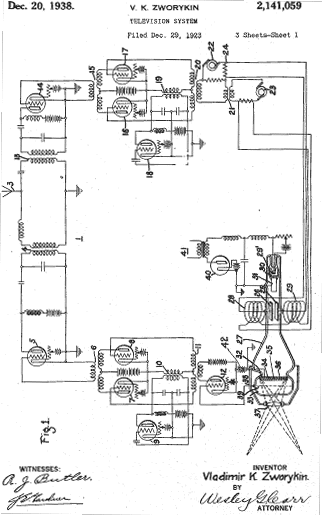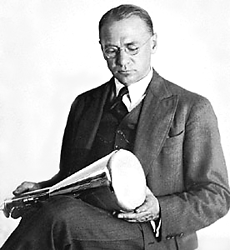

Vladimir Kosma Zworykin (Russian) (1889–1982)
Zworykin invented television transmitting and receiving systems employing cathode ray tubes. He was instrumental in the practical development of television from the early thirties, including charge storage-type tubes, infrared image tubes, and the electron microscope.
 Born in Murom, Russia in 1889, he studied at the St. Petersburg Institute of Technology, under Boris Rosing. According to the personal correspondence of Zworykin, he helped Boris Rosing with experimental work on television in the basement of Rosing's private lab at the School of Artillery of St. Petersburg. Rosing had filed his first patent on a television system in 1907, featuring a very early cathode ray tube as a receiver and a mechanical device as a transmitter. Its demonstration in 1911, based on an improved design, was among the first of its kind.
Born in Murom, Russia in 1889, he studied at the St. Petersburg Institute of Technology, under Boris Rosing. According to the personal correspondence of Zworykin, he helped Boris Rosing with experimental work on television in the basement of Rosing's private lab at the School of Artillery of St. Petersburg. Rosing had filed his first patent on a television system in 1907, featuring a very early cathode ray tube as a receiver and a mechanical device as a transmitter. Its demonstration in 1911, based on an improved design, was among the first of its kind.
Although most biographies maintain that Zworykin graduated in 1912 and thereafter studied X-rays under Professor Langevin in Paris, Zworykin gives the dates of having studied with Rosing as between 1910 and 1914. Be that as it may, During World War I. Zworykin was enlisted and served in the Russian Signal Corps, then succeeded in getting a job working for Russian Marconi, testing radio equipment that was being produced for the Russian Army. Zworykin decided to leave Russia for the United States in 1918 or 1919.  According to Albert Abramson's biography, he seems to have arrived in the U.S. at the end of 1918, and again at the end of 1919. This, if confirmed, would leave room for a sojourn to Paris to study under Paul Langevin, before moving back to the United States in December 1919.
According to Albert Abramson's biography, he seems to have arrived in the U.S. at the end of 1918, and again at the end of 1919. This, if confirmed, would leave room for a sojourn to Paris to study under Paul Langevin, before moving back to the United States in December 1919.
Once in the U.S. Zworykin found work at the Westinghouse laboratories in Pittsburgh, where he would eventually get an opportunity to engage in television experiments. He summarized the resulting invention in two patent applications, the first one, entitled "Television Systems", filed on December 29, 1923, followed up by a second application of essentially the same content but with minor changes and the addition of a Paget-type screen for color transmission and reception.
Zworykin described cathode ray tubes as both camera and receiver. The basic thrust of their operation was to prevent the emission of electrons between scansion cycles, a solution reminiscent of A.A. Campbell Swinton's proposal published in Nature in December 1911. This would result in the television signal being derived from the modest number of electrons released at the instant the cathode ray swept over an image point (pixel). The demonstration given by Zworykin sometime in late 1925 (not in 1923, as popular accounts would have it) was far from a success with the Westinghouse management, even though it showed the possibilities inherent in a system based on the Braun tube. Although he was told by management to "devote his time to more practical endeavours," Zworykin continued his efforts to perfect his system. As attested to by his own writing, including his doctoral dissertation of 1926, earning him a Ph.D. from the University of Pittsburgh, his experiments were directed at improving the output of photoelectric cells.
There were, however, limits of how far one could go along these lines, and so, in 1929, Zworykin returned to vibrating mirrors and facsimile transmission, filing patents describing these. At this time, however, he was also experimenting with an improved cathode ray receiving tube, filing a patent application for this in November 1929, and introducing the new receiver he now named "Kinescope", reading a paper two days later at a convention of the Institute of Radio Engineers.
 Having developed the prototype of the receiver by December, 1929 Zworykin met again with David Sarnoff, whom he had first visited in late 1928 to describe his television ideas. In early 1930, Zworykin decided to make the move from Westinghouse to RCA. "Moving the laboratory was not a very easy task" and the progress of his work was "delayed for several months". Sarnoff put him in charge of television development for RCA at their newly established laboratories in Camden, New Jersey.
Having developed the prototype of the receiver by December, 1929 Zworykin met again with David Sarnoff, whom he had first visited in late 1928 to describe his television ideas. In early 1930, Zworykin decided to make the move from Westinghouse to RCA. "Moving the laboratory was not a very easy task" and the progress of his work was "delayed for several months". Sarnoff put him in charge of television development for RCA at their newly established laboratories in Camden, New Jersey.
The difficult task of developing a practical all-electronic television system could begin. There was an in-house evaluation in mid-1930, where the Kinescope performed well with 80-line definition, but the television camera system was of a mechanical type. The breakthrough would come when the Zworykin team decided to develop a new type of cathode ray pickup tube, one described in French and British patents of 1928 priority by Hungarian inventor, Kalman Tihanyi, whom the company approached in July 1930, after the publication of his patents in England and France. Tihanyi's tube, the "Radioskop" was a curious design, one where the scanning electron beam would strike the photoelectric cell from the same side where the optical image was cast. Even more importantly, it was a system characterized by an operation based on an entirely new principle, the principle of the accumulation and storage of charges during the entire time between picture repetitions.
![]() According to Albert Abramson, these experiments started in April 1931, and after the achievement of the first promising experimental cameras, on October 23, 1931, it was decided: this new camera tube would be named "Iconoscope". The system was ready to be launched at the end of 1934, a contract had of course been signed with the Hungarian inventor for the purchase of his patents. In early 1935, the new tube was introduced in Germany. It was soon developed there, with some improvements, and was successfully used at the 1936 Berlin Olympic Games as one of several cameras, including Farnsworth's Image Dissector for film transmission only, broadcasting the games to some two-hundred public theaters.
According to Albert Abramson, these experiments started in April 1931, and after the achievement of the first promising experimental cameras, on October 23, 1931, it was decided: this new camera tube would be named "Iconoscope". The system was ready to be launched at the end of 1934, a contract had of course been signed with the Hungarian inventor for the purchase of his patents. In early 1935, the new tube was introduced in Germany. It was soon developed there, with some improvements, and was successfully used at the 1936 Berlin Olympic Games as one of several cameras, including Farnsworth's Image Dissector for film transmission only, broadcasting the games to some two-hundred public theaters.
Although the tube went through a number of adjustments and improvements, it continued to be called by the generic name of Iconoscope. According to some reliable claims, the secondary electron multiplier which formed part of the later Image-Orthicon camera pickup tube was the multiplier developed by Philo Farnsworth.
The developments in England by the British firm EMI had followed Tihanyi's original charge storage design under a patent exchange. After an amalgamation with Marconi Wireless and Telegraph Co., the EMI-Marconi electronic system was officially adopted by the BBC whose experimental public broadcasts began in England in November 1936 and initially included the Baird system. The British electronic system featured 405 scanning lines, while German television adopted 441 lines. RCA followed the initial (1934) 375 line definition, then upgraded to 441. 525 lines was adopted in 1941, known as the NTSC standard.
Zworykin retired in 1954. Throughout his steady rise in rank, he remained involved in the many important developments of the company and received several outstanding honours, including, in 1934, the Morris Liebmann Memorial Prize for his pioneering work.